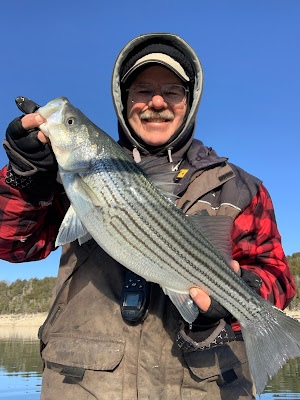You can find largemouth bass in several different types of areas. Bluff walls have been very productive. The fish can be up tight to the rocks or suspended out from the bluff. Most of these fish are 10 to 20 feet down either on the bottom or suspended over deep water. A-rigs are working great with white swimbaits. You can judge how heavy of a jig head you need
depending on the depth you want to get the bait to. Typical ¼ ounce works great. If you are using an A-rig that already has added weight to the center piece you may only want a hook with no weight. Crank baits, jigs and spinners are also producing some nice fish. There are still some nice fish hugging the bottom off of long rocky points from 30 to 40 feet down. My best way to catch these deep fish is to vertical jig a spoon slowly right on the bottom.Striped bass are still in their winter pattern. Basically, this is saying that the bait has moved out to the deep-water river channels or very close to the channel. You will find streams of bait 10 to 30 feet thick and the stripers will be very close by. I find the striped bass on top of the bait, at the bottom of the bait or some are even buried inside the bait. If there is a deep flat next to the channel you may find large schools of stripers cruising through the flat, but they always stay close to the large streams of bait. The bait is typically suspended 30 to 60 feet down. This depth will vary, and the thickness of the bait will vary. The fish will be found suspended at the same depths as the bait. There are various methods to fish for this species. Live
bait is a tried-and-true method, vertical jigging a one-ounce spoon, vertical jigging a 3-inch swim bait with a 3/8-ounce jig head or trolling swimbaits, umbrella rigs, or hard crank baits. The key is to get your bait at the same depth as the fish. This pattern will stick around until the water temperature starts to warm, which should be in the next couple of weeks. With the warmer water the bait tends to start to move back in the creeks or farther upriver. When the bait moves the stripers will be chasing.Crappie are on brush. Find brush in 20 to 40 feet of water. The fish will be at all depths depending on the time of day. Early and late in the day they are typically suspended on top of the brush and on occasion only 5 to 10 feet down. Mid-day they tend to drop a little deeper. Of course, the weather plays a big role on how the bait acts in the brush, and just like all fish species they tend to follow their food
source. This morning I hit a couple of brush piles. It was a very cloudy windy day and the fish seemed to be deeper and buried inside of the brush. Live bait, small twister tail grubs with a 1/16-ounce jig head and a small 1/8 – ¼ ounce spoon are all working great.Norfork Lake surface water temperature is holding in the 45 to
46 degree range but may start to rise slowly with the spring type weather we
are having. The lake level has been rising slowly with minimal power generation
and currently sits at 552.75 feet msl. The lake is trying to clear but still remains
slightly stained.
I post almost daily on Facebook. If you want more frequent
information, please visit and Like Hummingbird Hideaway Resort’s Facebook page.
Happy Fishing and enjoy Norfork Lake.












